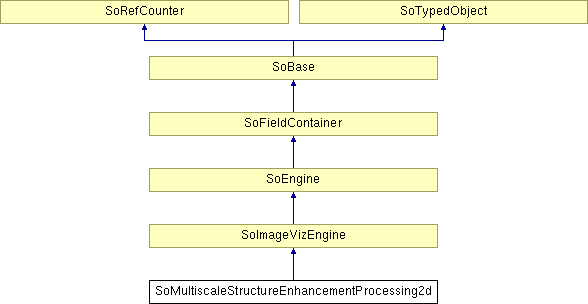SoMultiscaleStructureEnhancementProcessing2d Class Reference
[Texture Filters]
 SoMultiscaleStructureEnhancementProcessing2d engine
More...
SoMultiscaleStructureEnhancementProcessing2d engine
More...
#include <ImageViz/Engines/ImageFiltering/TextureFilters/SoMultiscaleStructureEnhancementProcessing2d.h>

Public Types | |
| enum | TensorType { HESSIAN = 0, GRADIENT = 1 } |
| enum | Lightness { BRIGHT = 0, DARK = 1 } |
| enum | StructureType { ROD = 0, BALL = 1 } |
Public Member Functions | |
| SoMultiscaleStructureEnhancementProcessing2d () | |
Public Attributes | |
| SoSFImageDataAdapter | inImage |
| SoSFEnum | tensorType |
| SoSFVec2f | standardDeviationRange |
| SoSFFloat | standardDeviationStep |
| SoSFEnum | lightness |
| SoSFEnum | structureType |
| SoImageVizEngineOutput < SoSFImageDataAdapter, SoImageDataAdapter * > | outImage |
Detailed Description
 SoMultiscaleStructureEnhancementProcessing2d engine
SoMultiscaleStructureEnhancementProcessing2d engine
Overview
The purpose of this algorithm is to enhance structures of interest from an image using a multi scale analysis. The result of this algorithm is a score image that can be used with the goal of segmenting the input image.
The SoMultiscaleStructureEnhancement filters compute a score between 0 and 1 for each pixel, 1 representing a good matching with a structure model and 0 a background pixel. This provides a powerful technique for automatically identifying structures such as blood vessels. The score can be computed either on an Hessian matrix to detect ridge structures or on a Gradient tensor for object edges and corners. The structure models available are:
- Balls (circular structures with Hessian in 2D, spherical in 3D, object corners with Gradient tensor)
- Rods (linear structures)
- Plates (only available in 3D)
The principle of the algorithm can be summarized as follows :
- A set of tensor fields is extracted from the image by filtering the image at different scales.
- A score image is extracted from each tensor field by analyzing the eigenvalues of tensors.
- The final score is obtained by selecting the maximum of all score images.
The following publication describes this algorithm when applied to detect Rod structures with the Hessian matrix: A.F.Frangi, W.J.Niessen, K.L.Vincken, M.A.Viergever, "Multiscale vessel enhancement filtering", Lecture Notes in Computer Science(MICCAI), vol. 1496, pp. 130-137, 1998.
Tensor Extraction
2 modes are available for computing the tensor field; the GRADIENT mode and the HESSIAN mode. The first one is based on the gradient tensor, the second one on the hessian matrix.
GRADIENT mode
In the GRADIENT mode, the gradient tensor is extracted. This tensor also referred to as structure tensor or second order moment matrix, is a matrix derived from the gradient of the image. This matrix summarizes the predominant directions of the gradient around the voxel of interest.

Where  is a gaussian kernel controlling the scale of analysis.
is a gaussian kernel controlling the scale of analysis.
HESSIAN mode
In this mode, the tensor field is based on the extraction of the hessian matrix of the image. This hessian matrix is computed by filtering the image with the derivative of a gaussian kernel. The standard deviation of the kernel controls the scale of analysis.
Feature extraction
The parameter structureType controls the type of structure that is extracted from the tensor field (ROD/BALL). Let  be the 2 eigenvalues of the extracted tensor.
be the 2 eigenvalues of the extracted tensor.
The score for StructureType2D::ROD corresponds to :

This score favors anisotropic tensors.
The score for StructureType2D::BALL structures is computed as follows :

This score favors isotropic tensors.
where  is the tensor norm,
is the tensor norm,  is a threshold which controls the blobness sensitivity, and c is a sensitivity threshold which controls the noise influence.
is a threshold which controls the blobness sensitivity, and c is a sensitivity threshold which controls the noise influence.  with
with  the maximum Hessian norm in the image.
the maximum Hessian norm in the image.
In the HESSIAN mode, the lightness parameter limits the feature extraction to dark or bright objects by analyzing the sign of eigenvalues. This parameter is ignored in GRADIENT mode where tensors are positive definite matrices.
The table below summarizes enhanced feature according to the parameters
| Structure Type |  |
|  | detected feature in GRADIENT mode | detected feature in HESSIAN mode | |----------------|-------------------|--------------------|:------------------------------------:|:---------------------------------:| | ROD | strong | weak | straight edge | ridge | | BLOB | strong | strong | edge corner/blob | blob |
| detected feature in GRADIENT mode | detected feature in HESSIAN mode | |----------------|-------------------|--------------------|:------------------------------------:|:---------------------------------:| | ROD | strong | weak | straight edge | ridge | | BLOB | strong | strong | edge corner/blob | blob |
SEE ALSO
SoMultiscaleStructureEnhancementProcessing3d.
FILE FORMAT/DEFAULT
- MultiscaleStructureEnhancementProcessing2d {
| inImage | NULL |
| tensorType | HESSIAN |
| standardDeviationRange | 1.0f 3.0f |
| standardDeviationStep | 1.0f |
| lightness | BRIGHT |
| structureType | ROD |
Library references: structureenhancementfilter
Member Enumeration Documentation
Constructor & Destructor Documentation
| SoMultiscaleStructureEnhancementProcessing2d::SoMultiscaleStructureEnhancementProcessing2d | ( | ) |
Constructor.
Member Data Documentation
Input image.
Type of the image can be integer or floating. Default value is NULL. Supported types include: grayscale image.
The lightness type of structures to enhance.
Use enum Lightness. Default is BRIGHT
| SoImageVizEngineOutput<SoSFImageDataAdapter,SoImageDataAdapter*> SoMultiscaleStructureEnhancementProcessing2d::outImage |
Output image.
Type of the output image is forced to float. Default value is NULL. Supported types include: grayscale image.
Standard deviation of the Gaussian kernel at minimum and maximum scale.
Default value is SbVec2f(1.0f,3.0f).
Standard deviation step.
Structures will be detected from min to max standard deviation at a pitch of this value. Default value is 1.0f.
Shape of structures to extract.
Use enum StructureType. Default is ROD
Defines whether the command will use the gradient tensor or the hessian matrix.
Use enum TensorType. Default is HESSIAN
The documentation for this class was generated from the following file:
- ImageViz/Engines/ImageFiltering/TextureFilters/SoMultiscaleStructureEnhancementProcessing2d.h